| |
 |
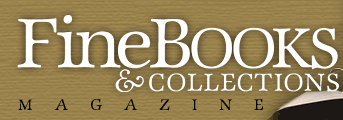 |
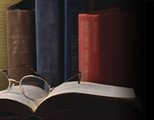 |
|
BOOK REVIEWS
English Bookbinding Styles,
1450–1800
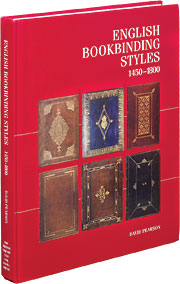
A Handbook
By David Pearson
New Castle, Del.: Oak Knoll Press, 2005
221 pages. $65.00
ISBN 1584561408
Binding styles remains an area in which even rare-book
specialists often feel under equipped or under-trained and it is one that
is often poorly served in catalogs
I know less about
bookbindings than I like to admit, a gap in my training that I suspect is
shared by many of my colleagues in special collections libraries.
Fortunately for my self-esteem, I am not alone, according to David Pearson,
who states in his recent book on English binding styles that the subject
“remains an area in which even rare book specialists often feel
under-equipped or under-trained, and one that is often poorly served in
catalogues.”
Pearson’s new book is printed in a large format (8H
by 11 inches), with hundreds of illustrations, a generous font size
for easy reading, and a helpful index. The main sections cover the meaning
and interpretation of bookbindings, materials and construction techniques,
decorative styles, the development of tool shapes over time, and the relationship
between bookbinders and the book trade.
Pearson wrote the book to “provide a toolkit of
information which will enable anyone working with or handling historic
bindings to know better what they are dealing with, and to create a
platform on which greater understanding can be built.” I decided to
test this claim by opening the toolkit, so to speak, and using its contents
to answer a question that has bothered me in a niggling way for years about
a specific binding in the John Carter Brown Library, where I work.
The volume contains two works by John Smith
of Pocahontas fame. The first is The True Travels (London, 1630),
and the second is The Generall Historie of
Virginia, New-England, and the Summer Isles
(London, 1627). I normally present this book in classes as being the copy
owned by Charles I of England, based on a statement to that effect on the
green morocco slipcase that protects the book, as well as our catalog record.
This attribution of provenance was based on the fact that the arms of Charles
I are stamped on the front and back covers in gold (I later learned that
James I, Charles I, Charles II, and James II all had the same coat of arms).
I am not a binding historian, and so had no
particular reason to doubt that the stamp of royal arms meant royal
ownership—and it was nice to discuss the book’s contents in
relation to such an owner. Pearson burst my bubble on page forty-seven,
when in a general aside he says that “throughout the timespan covered
by this book…royal insignia on bindings do not normally indicate
royal ownership—the use of royal arms or emblems was not
uncommon as a decorative device.” A search of the archives
revealed that the claim of royal ownership rested on a bookseller’s
shoulders and was part of his sales pitch. Henry Stevens offered this copy
to John Nicholas Brown on October 5, 1892:
Stevens was a master at painting a grand picture
in just a few strokes, deftly turning a defect into a potential selling point.
His claim that Charles I owned the book is not necessarily false, but in
light of Pearson’s statement there is no specific evidence that it
is true. What I have in
hand is at best a sophisticated (repaired) volume, rebound in its
original boards and spine. However, evidence can still be extracted from
what remains of the original binding.
Pearson’s book contains over 760 images
(diagrams, details of ornaments, pictures of bindings in black and white
and in color), and with it I assembled a nice file of evidence
about this binding, which, admittedly, is not one in which either
text was issued. To my mind, however, this fact makes the binding even more
interesting to understand as an artifact.
According to what I can determine from Pearson, it is a
typical early seventeenth-century centerpiece binding: the royal arms in
the center, within two concentric quintuple fillets (the middle or third
fillet is in gold, the rest are blind-tooled), the inner fillet having
gold-tooled fleurons at the corners. These fleurons are identical to one
of those shown in Pearson, who dates this ornament as being in common use
between 1590 and 1655. His cost information for types of tanned leathers
is another useful tidbit. Goatskin was most expensive, followed by calfskin.
Sheepskin was the cheapest leather. Thus,
the calfskin covers and the overall design mark the Smith binding as of a
type commonly found in a mid-market product manufactured in Cambridge between
1630 and 1655.
I must confess that I have withheld one piece
of evidence that is not part of the binding. There is a note, in a
seventeenth- century hand, at the top of the title-page of the first work
that seems to be related to the binding. It is dated 12 February 1648,
nicely within the range suggested by Pearson. Much like the original bookseller’s
optimistic cataloging, this statement was of uncertain value without the
other, confirming evidence from the physical object, which English Bookbinding Styles has allowed me to compile, present, and interpret. I
can’t think of better criteria by which to judge a great reference
book.
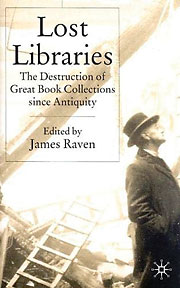 The Destruction of Great Book Collections Since
Antiquity The Destruction of Great Book Collections Since
Antiquity
Edited by James Raven
London: Palgrave Macmillan, 2004
294 pages. $65.00
ISBN 1403921199
An eyewitness account of the sacking and destruction of the Iraqi National Libraries in April 2003 leads Philip Hensher to note, “The burning of books…is so powerful a symbol of barbarism that the stench of it hangs in the air long afterward: It is something impossible to forgive, impossible to forget.” Unfortunately, this was not the first time books were destroyed in Iraq. According to Lost Libraries, “Genghis Khan’s grandson burnt the city in the thirteenth century and, so it was said, the Tigris River ran black with the ink of books.” Lost Libraries offers
a sobering reminder of the fragility of book collections. Editor James
Raven’s introduction sets the tone for the subsequent essays. It is
also the best piece in the book, cogently surveying a couple thousand years
of catastrophes that have befallen libraries. The other contributors consider
specific examples of book dispersals and their implications.
The essays also explore how the systematic destruction
of books and libraries can be used as a tool of propaganda for both the pillager
and the victim. The conqueror tries to obliterate the culture, the language,
and the morale of the conquered. The conquered sometimes exaggerate the damage
to great collections to illustrate the barbarity of the conqueror. There
are many dramatic stories of the burning of Alexandria’s library on
the orders of Julius Caesar and Caliph Omar, but modern scholars have
discovered these are myths that conveniently mask the likelihood that the
collections gradually degraded over centuries. Lost to our cultural memory,
however, is the story of the destruction of Europe’s greatest
medieval library, assembled by the Hungarian scholar-king Matthias
Corvinus.
Sometimes libraries are destroyed by dispersing
books rather than burning them, and that loss becomes someone else’s gain.
This equation is elaborated in essays by Nigel Ramsay about the breakup of
English libraries following Henry VIII’s reformation and by Dominique
Varry on the seizure of private libraries during the French Revolution. These
social upheavals redistributed vast collections of incunabula, manuscripts,
and printed books. Many treasures were lost, but many found their way into
the British Library and the Bibliothéque Nationale, which made the
works available to the public for the first time.
The twenty-first century isn’t immune to the
destruction of collections. There are modern human catastrophes—the
fall of Baghdad, the occupation of Tibet—which
orphan or destroy many books. The de-accessioning of books and periodicals
by modern libraries creates new controversies for debate, diasporas for scholars
to pursue, and opportunities for collectors to buy.
The essays, as individual pieces, are intensely
focused on specific historical periods and subjects, as opposed to the epochal
scope and themes in another book on the subject, Matthew Battles’s Library: An Unquiet History.
Collectors and readers alike will appreciate
Lost Libraries. The writing is lucid and engaging, too often a rarity in
scholarly literature, and the passion of the authors is palpable.
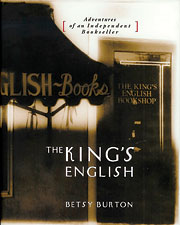 Adventures of an Independent Bookseller Adventures of an Independent Bookseller
By Betsy Burton
Layton, Utah: Gibbs
Smith, 2005
312 pages. $24.95
ISBN 1586856871
This episodic history of Betsy Burton’s bookstore, the King’s English, reflects the recent story of independent bookselling. Burton and her first partner, Ann Berman, opened the shop in 1977, fueled by an enthusiasm for good literature and a dream of creating a hangout for book lovers in Salt Lake City. Neither partner knew much about running a business, but over time they learn how to negotiate with sales reps, stock inventories, assess and shape the reading tastes of their customers, and thwart the pilfering hands of larcenous employees. When a passion for books is no longer enough to make ends meet, they face the challenges bedeviling all independent booksellers: computerization and the Internet; chain stores and publishing monopolies; and the perennial bugaboo of civilization, censorship. At the King’s English, censorship evolved from objections over feminist literature in the 1970s to the Patriot Act in the 2000s. There are also the challenges unique to running a bookstore so near the headquarters of the Mormon Church. When Jon Krakauer comes to speak about his book on Mormon fundamentalism, Burton finds herself working with a private detective, the local vice squad, and a martial arts expert to provide security. She wonders where the line is between satisfying the wants of customers and squelching free speech. The most entertaining parts of the book are
anecdotes about famous and not-yet-famous authors who stop by the King’s
English on their book tours. Isabel Allende is as colorful and passionate
in person as her novels suggest, even during Utah’s winters, and
British mystery writer John Mortimer endures a series of miscalculations
with the aplomb of his defining literary character, barrister Horace
Rumpole. There are
even author signings where nobody shows up.
Burton doesn’t shy from self-examination. She
ruefully notes that she lost a series of business partners due to personal
differences and has failed often as a manager. Her candor balances the
book’s frequently informal and praise-laden prose.
And then come the lists. Burton assembles eighteen
lists of recommendations of books published or sold by the shop. The lists
range from the expected “25 Favorite Young Adult Books,” to those showing the
spirit of independent booksellers—“25 Thrillers with Moral
Heft.” The
appendix offers advice from other booksellers around the country. Many
readers may find good recommendations in these lists, but I found them
ultimately overwhelming. Is Burton competing against Nancy Pearl’s Book
Lust?
The King’s English caught
my eye because of its polished packaging and good page design, and anyone
passionate about independent bookstores should read this story. It suggests
there’s hope for the independent spirit in the twenty-first century.
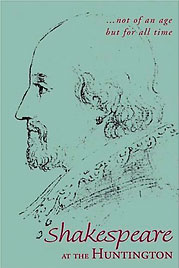 Shakespeare at the Huntington Shakespeare at the Huntington
by Jane Purcell
San Marino, Calif.: Huntington Library, 2005
85 pages. $12.95
ISBN 0873282019
This is a pleasing book for anyone with an interest in Shakespeare’s life and works. Jane Purcell, a high school teacher, offers far more than a handbook or guide to the Huntington Library’s Shakespeare holdings. The book’s eighty-five pages contain ninety-eight illustrations—including the inevitable title-pages and portraits, as well as art inspired by the plays and modern-day photographs of the library. Purcell’s command of Shakespeare scholarship comes through on every page, but the knowledge is worn lightly and served up with a palatable style. The chapters cover Henry Huntington as a collector;
the authorship controversy; Shakespeare’s life, works, and sources; “bardolatry”—the
idolization of Shakespeare; and fakes and forgeries.
Purcell’s book is a good model for libraries
to follow, as it is a publication that successfully straddles the generic
divides between a monograph, an in-house guide, and an exhibition catalog.
|
|
|
